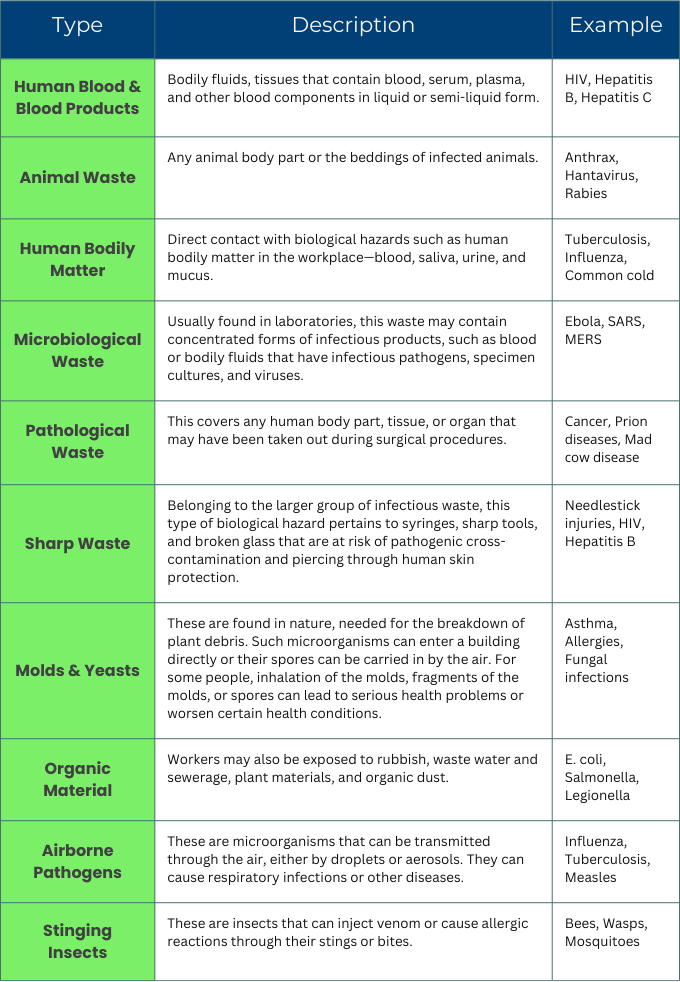Table of contents

What is a Biological Hazard?
Biological hazards, also known as biohazards, are any biological substance that poses a threat to the health of living organisms, primarily humans. poisons, bacteria, viruses, fungi, and parasites. Numerous health consequences, ranging from mild skin irritation to serious infections and even cancer, can result from exposure to biological risks.
Types of Biological Hazards
Biological dangers in the workplace come in a variety of forms. Here are ten typical biological hazard categories and some instances of each:
Sharp waste
This kind of biological hazard, which falls under the broader category of infectious waste, concerns sharp objects like needles, broken glass, and equipment that can pierce human flesh and spread pathogens.
Airborne pathogens
These are microorganisms that may spread across the atmosphere via aerosols or droplets. Infections of the respiratory system or other illnesses including COVID-19, influenza, measles, and TB can be brought on by them.
Human bodily fluids
Direct contact with biological hazards such as human bodily matter in the workplace— saliva, urine, and mucus—is highly risky.
Human blood and blood-derived materials
Because human blood and blood products may contain infectious diseases, they can be a major biological danger. Among them are the viruses that cause hepatitis B, hepatitis c, and the human immunodeficiency virus (HIV).
Microbiological waste
This waste, which is typically found in labs, might include concentrated infectious products like viruses, specimen cultures, blood, or other body fluids containing infectious diseases.
Pathological waste
This includes any organ, tissue, or bodily component removed from a patient during surgery. Infectious pathogens that may lead to illnesses including cancer, prion disorders, mad cow disease, and Creutzfeldt-Jakob disease can also be found in pathological waste.
Animal waste
Biological hazards also include any animal body part and the bedding of animals that have the infection. Animal excrement such as droppings may include pathogens that can infect people or other animals, such as bacteria, viruses, parasites, or other microbes.
Molds and yeasts
These are prevalent in nature and are essential to the decomposition of plant matter. These microbes can penetrate a structure directly or by the airborne dissemination of their spores. In rare cases, breathing in mold spores, fragments, or pieces of mold can aggravate pre-existing medical diseases such as hypersensitivity pneumonitis, allergies, asthma, or fungal infections.
Organic material
Additionally, garbage, sewage, plant materials, and organic dust may be present for workers. Bacteria, viruses, fungi, and parasites that may cause illnesses including salmonella, giardia, E. Coli, and legionella can be found in organic material.
Stinging bugs
These are the insects that have the ability to bite or sting people, inject venom, or trigger allergic responses. Insects that may sting include mosquitoes, fire ants, hornets, wasps, and bees.

Workplace Examples of Exposure to Biological Hazards
Workers in different environments or businesses may encounter various types of biological risks. Workers may be exposed to various instances of biological hazards such as:
- When working on repair, demolition, or excavation projects, construction workers may come into contact with dust, mold, animal feces, and airborne infections. Asthma, allergies, infections, and respiratory issues can all result from them.
- While working with livestock, crops, or soil, agricultural workers may encounter animal excrement, organic debris, stinging insects, and zoonotic illnesses (diseases that animals can transmit to people). These may result in infections, parasite illnesses, gastrointestinal issues, and skin irritation.
- As laboratory personnel handle, test, or dispose of biological samples or materials, they may be exposed to human blood and blood products, microbiological waste, pathological waste, and sharps waste. These may result in wounds, infections, and bloodborne illnesses.
- Manufacturing workers may be exposed to organic material, molds and yeasts, and airborne infections while working with food, wood, paper, or textile items. Food poisoning, allergies, infections, and fungal disorders can all be brought on by them.
Regulations that Target Biological Hazards
Globally, there are a number of legislation that address biological risk management. The purpose of these regulations is to shield the environment and employees from the damaging effects of biohazards. Among the key rules are:
- The International Labour Organization (ILO) Convention No. 155 on Occupational Safety and Health and the Working Environment, mandates businesses to take precautions to make sure employees aren’t exposed to biological risks that might damage their health or safety.
- The World Health Organization (WHO) International Health Regulations, provide a framework for the avoidance, identification, and handling of global public health emergencies, particularly those brought on by biological threats.
- The European Union (EU) Directive 2000/54/EC on the protection of workers from risks related to exposure to biological agents at work, outlines the conditions for handling and storing biological dangers and divides biological agents into four risk classes according to the degree of hazard.
- The United States (US) Occupational Safety and Health Administration (OSHA) Bloodborne Pathogens Standard, controls the amount of human blood and other potentially infectious materials that workers are exposed to. These materials may include bloodborne diseases including HIV, hepatitis B virus, and hepatitis C virus.
- The Canada Human Pathogens and Toxins Act regulates biosafety standards and containment procedures for labs and facilities that work with biological risks. It also controls the import/export, handling, usage, manufacture, storage, and disposal of human diseases and toxins.
Help Mitigate Biological Hazards
As you can see, biological hazards pose a major risk to both the environment and the health and safety of workers. As a result, having a thorough and practical strategy for handling biological safety threats at work is crucial.
Certainty is a powerful and easy-to-use solution for managing biological hazards in the workplace. With Certainty, you can:
- Create and conduct inspections, audits, and risk assessments implementing customizable checklists and forms that cover all aspects of biological hazard identification, evaluation, and control.
- Collect and analyze data using a secure and cloud-based platform that allows you to access and share information anytime and anywhere.
- Generate reports and dashboards that provide you with insights and trends on your biological hazard performance, compliance, and risks.
- Assign and track corrective actions that help you address and prevent biological hazards and their adverse effects.
Download our free Personal Protective Equipment (PPE) Assessment Checklist today.
Request a demo today and see how Certainty can help you mitigate biological hazards and improve your workplace safety and health.



